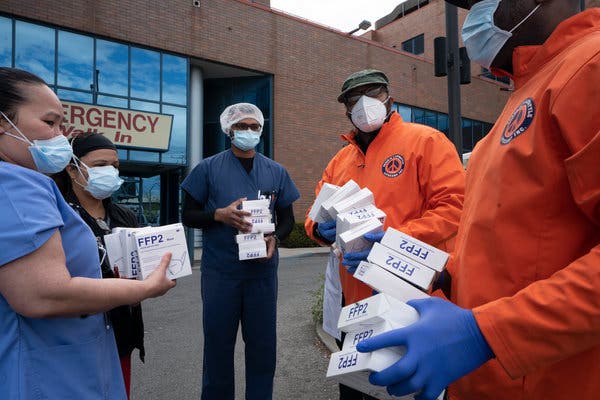[Want to get New York Today by email? Here’s the sign-up.]
It’s Wednesday. The subway shut down overnight, from 1 a.m. to 5 a.m. The decision to halt round-the-clock service is aimed at providing more time for the disinfecting of trains, equipment and stations during the pandemic. No end date has been set for the nightly shutdowns.
Weather: Chance of rain increases through the day. High in the mid-50s.
Alternate-side parking: Suspended through Tuesday. Meters are in effect.
New York is ordered to hold its Democratic presidential primary.
A federal judge on Tuesday ordered New York election officials to hold the state’s Democratic presidential primary in June and reinstate all qualifying candidates to the ballot. The ruling came after the vote was canceled late last month over concerns about the coronavirus.
The order, filed by Judge Analisa Torres of Federal District Court in Manhattan, came in response to a lawsuit filed by Andrew Yang, a Democratic presidential candidate who suspended his campaign.
Mr. Yang sued the New York State Board of Elections last week over its decision in late April to cancel the contest, a move it attributed to health and safety concerns and the fact that the results would not change the primary’s outcome.
Late Tuesday, Douglas A. Kellner, a co-chairman of the election board, said the panel was “reviewing the decision and preparing an appeal.”
The decision to cancel the primary drew an immediate backlash from the campaign of Senator Bernie Sanders, whose April decision to suspend his presidential bid made former Vice President Joseph R. Biden Jr. the presumptive Democratic nominee.
[Get the latest news and updates on the coronavirus in the New York region.]
A new count reveals 1,600 more deaths at nursing homes.
The coronavirus crisis at New York’s nursing homes is even worse than believed.
New Health Department statistics released late Monday included the previously undisclosed deaths of more than 1,600 people who were presumed to have died of the virus at nursing homes but who had not received a confirmed diagnosis.
By May 3, according to the new data, 4,813 people had died of the virus at nursing homes. The new data did not include nursing home residents who died in hospitals.
The number of deaths of nursing home residents, either at homes or in hospitals, was 3,025 on April 28, and about 100 more people died at nursing homes from April 29 to May 2, according to state figures.
[Coronavirus in New York: A map and the case count.]
Connecticut schools will be shut for the rest of the academic year.
Gov. Ned Lamont said on Tuesday that in-person classes at all public K-12 schools in Connecticut would be canceled for the rest of the academic year and that online learning would continue as the state prepared for a partial reopening this month.
Mr. Lamont’s move came after Gov. Andrew M. Cuomo of New York and Gov. Philip D. Murphy of New Jersey took the same step. Like his fellow governors, Mr. Lamont said he would issue guidance on summer school in the coming weeks.
Connecticut schools must continue to provide children who need them with meals that can be eaten at home, the governor’s office said in a news release.
What we’re reading
Admissions for New York City’s most selective schools could change after the coronavirus outbreak. [Chalkbeat New York]
The New York attorney general’s office began an investigation late last year into allegations of sexual harassment, retaliation and gender discrimination at NBC News. [Variety]
Two men were stabbed with what appeared to be a small sword while on a bus in Manhattan, the police said. [New York Post]
And finally: ‘Poetry in Motion’
The Metropolitan Transportation Authority will use many tools in coming weeks in its effort to restore faith in a subway system that has been seen as a vector for infection.
Disinfectant and the backbreaking work of dedicated employees, along with public relations strategies and the advice of medical professionals are likely to be vital. But the agency, it seems, will also employ poetry.
The people who pick the verse routinely displayed inside subway cars as part of the “Poetry in Motion” series are already thinking about which works might lift up the spirits of riders and speak to the city’s place at the center of a global crisis.
“We are very aware that when people begin using the subway and buses again in greater numbers, there is going to be this sense of anxiety,” said Matt Brogan, the executive director of the Poetry Society of America, which runs the subway program with the M.T.A. “The poems have always played a role in making the space welcoming.”
Sandra Bloodworth, the director of the M.T.A.’s arts and design program, said that beginning last month, people involved with “Poetry in Motion” began thinking about how to make sure that the next works are “thoughtful and mindful.”
Beyond elements of happiness, she said, the new poems should reflect the complex reality brought on by the coronavirus and the difficulties that the city has endured.
“What we present is more important than ever,” Ms. Bloodworth said. “We knew it was going to be a daunting challenge to find just the right thing to speak to, but also to comfort people.”
Nothing has been chosen yet, but Mr. Brogan said they were looking for poems that might match the tone of “Separation” by W.S. Merwin, a three-line poem that has previously appeared in the subway.
Your absence has gone through me
Like thread through a needle.
Everything I do is stitched with its color.
“It’s a beautiful poem,” he said, “but also really powerful at this moment because it’s about what happens when you’re absent from others and what you take with you.”
It’s Wednesday — express yourself.
Metropolitan Diary: Salsa night at the museum
Dear Diary:
I had been living in Brooklyn for a few months and I hadn’t made many new friends yet. I decided to go to a salsa party the Brooklyn Museum of Art was hosting on a cold February night.
I was feeling tired on my way home after what had been a long day at work, but I resolved to go on with my plan. Admission was free that night, and I hadn’t been to the museum before, so I dragged myself there to at least see it, even if I didn’t end up dancing.
When I arrived, the lobby was full of swirling bodies moving to the music. I stepped away from the commotion to take in a statue.
An older woman approached and was admiring the statue as well. She had a strong Brooklyn accent and a bad knee. She said she was upset that she couldn’t dance, but she also wanted to take the opportunity to browse the museum at no charge.
She and I spent the next couple of hours walking around the museum together, swapping stories, observing art and listening to the music. She told me how much she had seen Brooklyn change since her childhood.
It was only right before we left that we exchanged names. We never exchanged contact information. But we had a nice time, and I left the museum feeling warm, fulfilled and uplifted.
Thanks for a lovely evening, Rochelle.
— Natasha Paulmeno
New York Today is published weekdays around 6 a.m. Sign up here to get it by email. You can also find it at nytoday.com.
We’re experimenting with the format of New York Today. What would you like to see more (or less) of? Post a comment or email us: [email protected].



















